Note: This article was updated by the author in early 2021 having obtained more current data relating to emissions from precious metal mining and recycling. The end result is a reduction in the discrepancy between recycled and primary precious metals, though primary production of both platinum and gold remain heavy polluters.
In the lead up to the Australian Federal election one of the big topics is climate change.
And whether the two main parties want to acknowledge it or not, the global scientific community agrees that human activity is a major contributor to global warming.
We’re at the point now where we have to do everything we reasonably can to reduce the rate of global warming. And, believe it or not, jewellery has a part to play in that.
What impact does the jewellery industry have?

Open cut gold mine in Western Australia. One of the world’s largest man-made holes.
The biggest impact the jewellery industry has is from greenhouse gas emissions generated through mining, minerals processing and manufacturing. But it also has a big negative impact when land is cleared to access valuable gemstones, diamonds and precious metals like gold, platinum and silver.
That said, the jewellery industry is a relatively small player compared with things like electricity generation, agriculture and transport.
Importantly though, weight-for-weight, the ingredients that go into your jewellery have a dramatically higher carbon cost than many other day-to-day items.
On the face of it, that sounds bad, but in many ways it’s good news. It’s good news because when you make a thoughtful decision about the jewellery you buy you can have a surprisingly big positive impact even when the thing you’re buying might only be small.
Let’s talk about silver, gold and platinum, aluminium and steel
Most people when they think jewellery, think gold and silver and maybe platinum. And when they think metals and mining, they often think steel and aluminium.
So, how do they stack up?
Table 1 below shows how much CO2e is generated by mining and refining these metals. (By the way, I’m using CO2e – carbon dioxide equivalents – as short hand for Greenhouse Gases.)
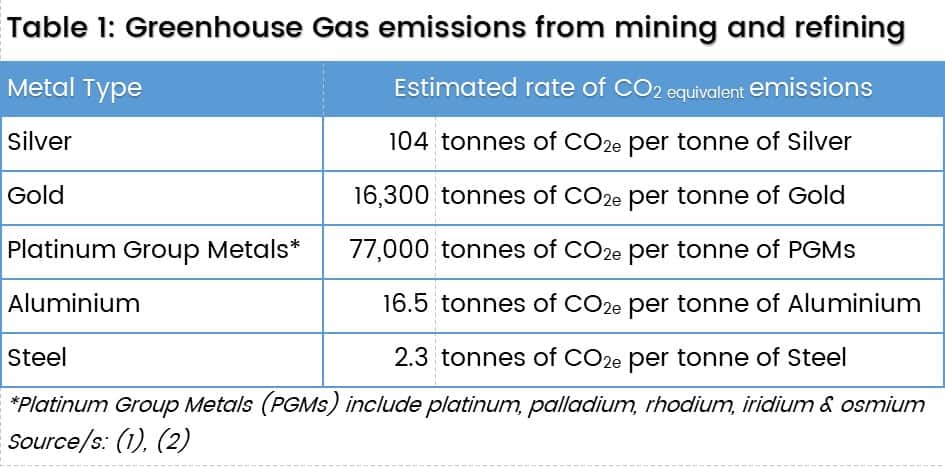
As you can see, the precious metals used in jewellery are a lot more polluting weight-for-weight than more common metals like steel and aluminium.
But of course, we use a lot more steel and aluminium day-to-day than we do silver, gold and platinum. So is jewellery something we really need to worry about?
The CO2e savings can be huge
Recycling is an extremely effective way to reduce greenhouse gas emissions from metals, precious or otherwise.
The chart below shows just how big the savings can be:
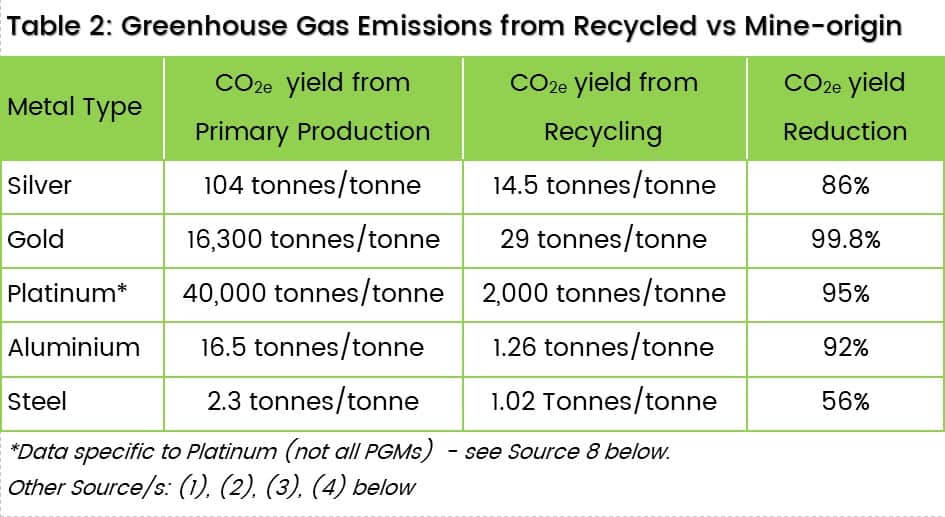
The problem with the really big numbers like those shown in Table 2 is it’s hard to relate them to pieces of jewellery that might only weigh a few grams.
An everyday object as a standard
It’s hard to imagine what it means to produce or save tonnes of a gas. So, in an effort to come up with something the average person can relate to, I decided to work with the humble aluminium can.
Most of us know what they look like and how big they are. All we need to do is figure out what difference it makes when we recycle one.
The average 375ml aluminium drink can weighs around 14.9 grams empty(5).
From that it’s easy to calculate how many grams of CO2e are produced when a can is made with mine-origin aluminium as opposed to recycled aluminium – as Table 3 shows:
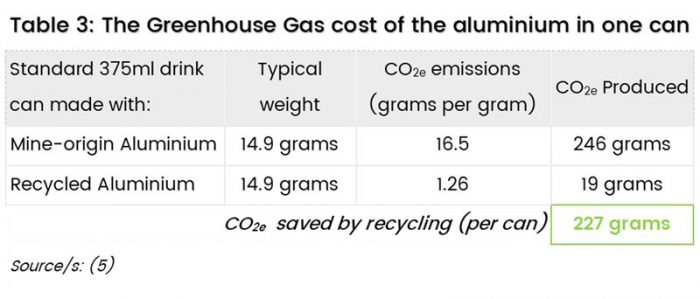
In other words, what this table tells us is recycling one aluminium drink can reduces greenhouse gas emissions by about 225 grams.
How do aluminium cans relate to jewellery?
Short answer, they don’t – except as a way of visualising the carbon cost of the jewellery you buy.
We can all imagine what a pile of drink cans looks like. It’s not so easy to imagine what a kilo of greenhouse gases looks like.
Time for some real-world examples
Let’s suppose you’re looking to buy some jewellery. Perhaps a pair of simple ear studs, a 45cm x 1.5mm cable neck chain and maybe a plain band ring (like a wedding ring).
Each item will have a different weight depending on which metal it’s made from – shown in Table 4:
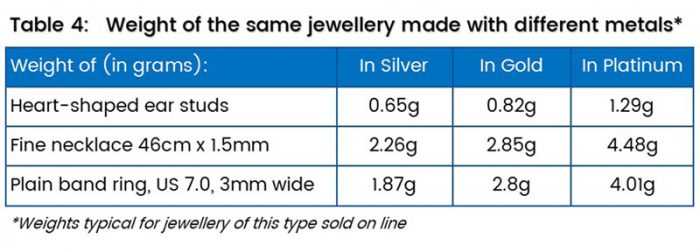
As you can see, platinum is the heaviest. This is unfortunate because platinum is also the worst offender when it comes to generating greenhouse gases from mining and refining.
What are the greenhouse gas savings when you choose recycled over mine-origin?
In Table 5 below, you’ll see I’ve calculated he approximate CO2e emissions by metal type for each piece of jewellery. In each case showing how much of a saving can be had when choosing recycled metals.
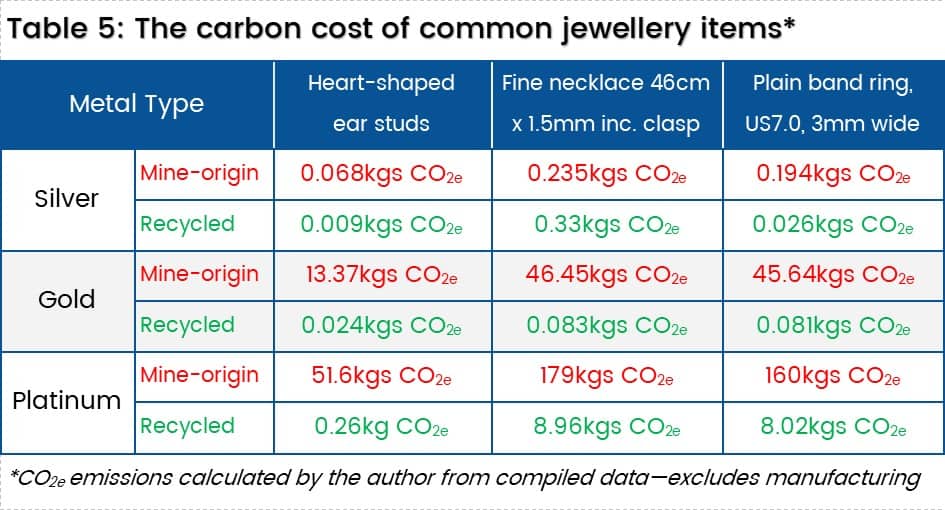
The table above reveals that some hefty emissions savings can be had by switching to recycled metals, especially when buying gold and platinum jewellery. The savings are much smaller when it comes to silver jewellery, but then, primary silver still has to be dug out of the ground.
How many cans is that?
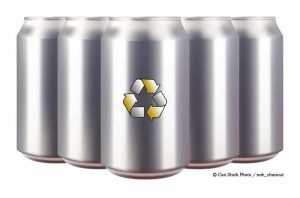
How many aluminium cans would you need to recycle to offset the carbon cost of your jewellery? Any ideas? It could be a lot more than you ever imagined!
So, let’s look at these numbers again, but this time replacing the emission figures with the number of aluminium cans you’d have to recycle to make up the difference.
We already know recycling an aluminium can saves around 225 grams in greenhouse gas emissions.
What Table 6 below shows is how many cans you’d have to recycle to compensate for choosing mine-origin metal over recycled metal when you buy your jewellery.
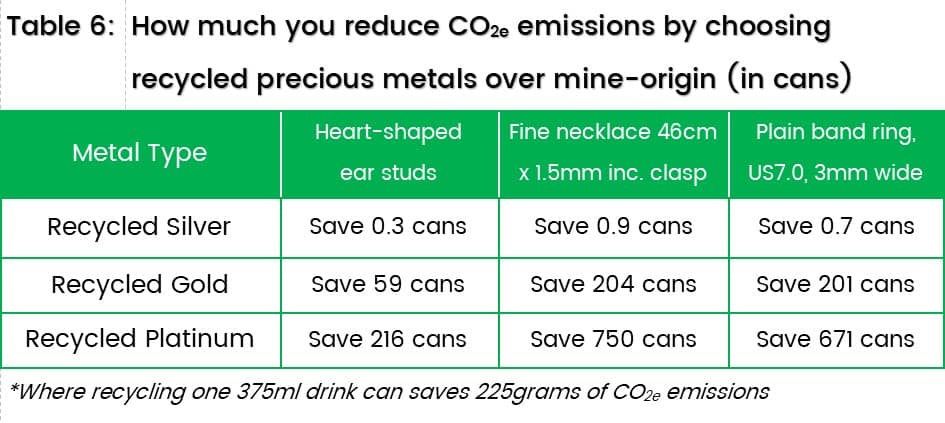
Imagine having to find and recycle 204 cans to off-set the emissions from just one fine gold necklace. That’s the same as 34 six-packs!
Is there any reason to choose mine-origin instead of recycled?

Artisanal gold miners in Poura, Burkina Faso, West Africa. (Photo by Gilles Paire)
When it comes to non-essential items like jewellery, in my view there’s only one reason to consider mine-origin over recycled, and that’s to support the livelihoods of small mining communities in developing countries.
You can do that by purchasing Fair Trade gold and silver. Importantly, by supporting those communities you also help to reduce emissions by helping them become more efficient.
Plus, Fair Trade certification also means producers are less polluting, do not allow exploitation and are much safer workplaces.
(Unfortunately, Fair Trade platinum is not an option. The chemical nature of platinum means it can only be extracted and refined using capital intensive and highly industrialised processes.)
What about diamonds and gemstones?
If you thought the whole precious metals thing was complicated, it gets way more so when it comes to diamonds and coloured gemstones. Especially as laboratory grown alternatives to both are now commonly available.
Current reports suggest that for every one carat of diamonds produced, approximately 57kgs of greenhouse gas emissions are released into the atmosphere(6).
As it turns out, this figure is also a good generalisation for lab-grown diamonds where renewable energy is used. (Unfortunately, many lab-grown producers rely on coal-fire and gas generated electricity for their energy-hungry production processes resulting in carbon emissions much higher than for most mine-origin diamonds.)
That means, regardless of whether you choose mine-origin or lab-grown, in aluminium can terms you’d need to recycle about 250 cans to offset one carat of diamonds.
But when it comes to mine-origin coloured gemstones, because almost 80% of the world’s supply comes from artisanal small-scale mining. Most of this is in developing countries which make it really hard to put a finger on what the associated greenhouse gas emissions are.
Similarly, the lab-grown gemstone industry generally doesn’t report on that kind of information, so no one really knows.
Under these circumstances it’s probably fair to say that greenhouse gas emissions associated with coloured gemstones are less than those for diamonds, but probably quite a bit more than nothing.
As it is for precious metals, if climate change is your number one concern, then recycling should be your go-to option.
“That’s all well and good, but don’t ‘green’ products cost more?”
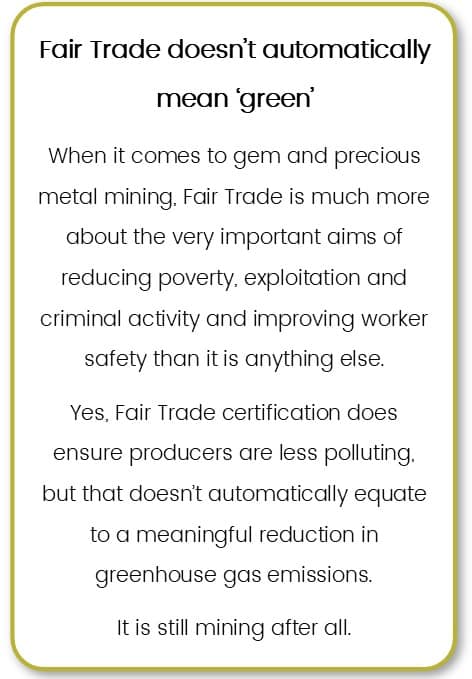 It’s not uncommon to find that ‘green’ products cost more, but that’s certainly not the case when it comes to jewellery.
It’s not uncommon to find that ‘green’ products cost more, but that’s certainly not the case when it comes to jewellery.
Precious metals like gold, silver and platinum are all traded as commodities on international markets. That means their prices are the same regardless of their origin – mine, recycled or wherever.
In other words, there’s no financial downside to choosing recycled metal over newly mined.
It’s a different story for recycled diamonds and gemstones however. The potential savings vary wildly depending on the popularity of the type, size and shape of the stones you want. Even so, you could end up paying 20% to 80% less than ‘new’ prices.
Of course, if you’re just buying retail jewellery over the counter you don’t often get the option to buy recycled diamonds or gemstones. But if you’re having something made for a special occasion, it can be very worthwhile checking out what’s available.
What’s the take away?
What I really want to get across is that the choices you make when you buy jewellery really are important.
Every piece of jewellery you buy costs the planet something and it’s within your power to decide whether that cost is going to be big or small.
This is even more the case if you’re the kind of person who likes to wear a lot of jewellery and you’re concerned about the environment.
When you consider the jewellery industry is worth about US$270 Billion globally each year(7), it really is an industry worth cleaning up as much as we can.
And all you need to do to make a very real difference is to give just a little bit more thought to your next purchase and demand more responsibility from your jewellery supplier.
References:
- Usapein & Togcumpou, ResearchGate.net Greenhouse Gas Emission in Jewelry Industry: A Case Study of Silver Flat Ring, 2016 Note: The ‘silver ring’ standard used in this study is reported as weighing 9.3 grams with silver mining and production CO2e emissions being taken as 0.97kgs/ring – as cited in the research. This equate to 104kgs CO2e/kg of primary silver.
- World Gold Council, 2017: Gold & Climate Change Report, 2018
- World Steel Association, 2017
- Australian Aluminium Council, 2018
- Pub-Med – US National Library of Medicine: Recycling of metals: accounting of greenhouse gases and global warming contributions.
- Frost & Sullivan, 2018: Environmental Impact Analysis: Production of rough diamonds
- Statista: Global Jewelry Market – Statistics & Facts
- Closing the loop on platinum from catalytic converters: Contributions from material flow analysis and circularity indicators – by Saidani, Kendall, Yannou and Leroy – published in the Journal of Industrial Ecology in April, 2019
About EJA
Ethical Jewellery Australia is an online engagement, wedding ring specialist and bespoke jewellery specialist. Every piece we do is custom designed and made to order (with the exception of simple wedding and commitment rings that are offered in a range of simple, popular designs).
We take our customers through the whole process from design to sourcing and finally to manufacturing.
All rings are handmade in Australia with recycled metals. (We can also supply Fair Trade gold if requested.)
Likewise, we only every use ethically sourced diamonds and gemstones. You can choose from Argyle, recycled, vintage and lab-grown diamonds, Australian, US, Fair Trade, recycled and lab-grown coloured gemstones.
By the way, we offer an Australia-wide service.
About the Author: Benn Harvey-Walker
Benn is a Co-founder of Ethical Jewellery Australia and a keen student of ethical and sustainability issues in the jewellery world. He has a long history in sales and marketing and began working with EJA full time in early 2018.
Benn co-authored the original Engagement Ring Design Guide in 2014 and edited the 2nd Edition in 2018. He is also the principal author of our Wedding and Commitment Ring Design Guide.
His main responsibilities at EJA are business development and sales process management. Benn also creates technical drawings for our ring designs.

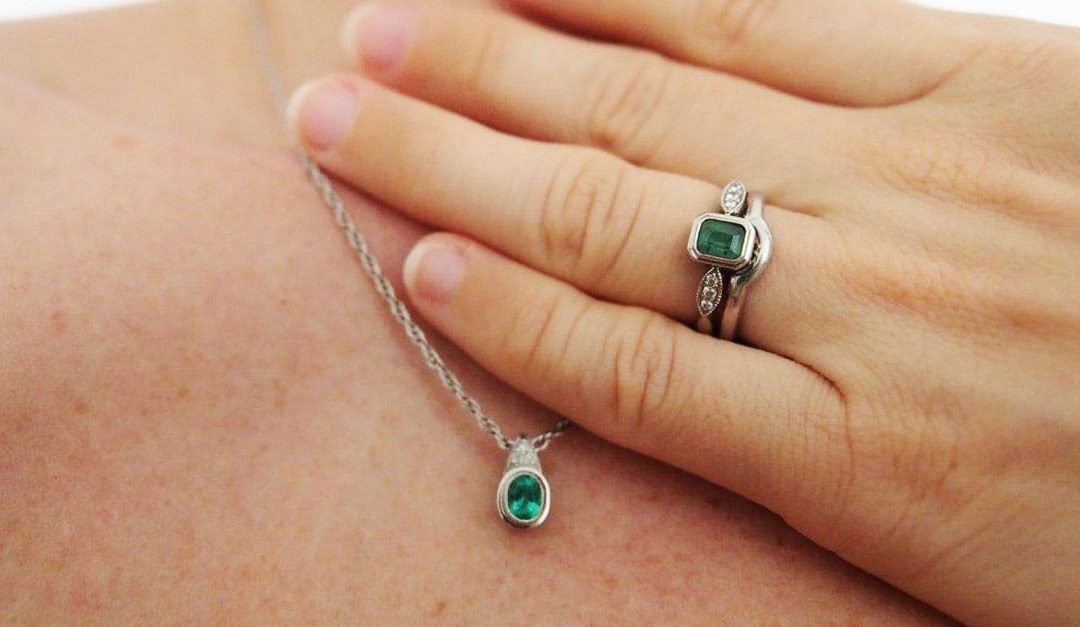
Recent Comments